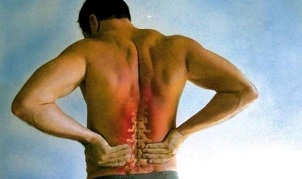
Back or lumbar pain is the most common complaint of patients in general medical practice. They rank second (after respiratory diseases) in terms of the frequency of requests for medical care. There are many diseases that lead to pain. But the most common cause is osteochondrosis of the lumbar spine, the symptoms and treatment of which we will discuss in this material.
Relatively recently, medicine considered this condition as age-related changes in the spine, which were associated with the natural aging processes of the human body.
Today, lumbar osteochondrosis is considered a very serious disease that occurs in people of all age groups. Currently, the incidence has a steady tendency towards recurrence, more and more often the disease is diagnosed in people under the age of 30 years.
Causes of occurrence
The reason for the development of lumbar osteochondrosis has not yet been established. But when faced with this pathology, it is often possible to assume who is more prone to the disease, is at risk.
Predisposing factors:
- Passive lifestyle. This includes people who lead a mostly sedentary lifestyle. In a sitting position, the corset muscles relax, which increases the load on the lumbar spine.
- Hormonal metabolic disorders and endocrine diseases can adversely affect metabolism in spinal tissues and contribute to the development of osteochondrosis.
- Various congenital and acquired abnormalities in the structure of the musculoskeletal system - curvature of the legs and back, flat feet.
- Presence of a constant heavy physical strain on the back, in particular, lifting heavy objects. In this case, we can talk about an occupational disease of categories such as weightlifters and people whose professional tasks are associated with the constant erection of heavy objects.
- Continuous unhealthy diet and daily routine, regular stress, insufficient sleep time, metabolic disorders.
The points listed above are the most common factors that create the preconditions for the development of the disease.
Degrees of medial osteochondrosis
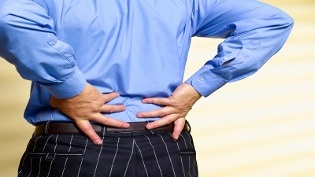
Manifestations of the disease depend on the degree of development of the pathology.
There are four degrees of osteochondrosis:
- The period of change and movement of the nucleus pulposus within the disk. The pain appears due to irritation of the nerve endings located in the anus fibrosus and the longitudinal ligaments. The patient feels local discomfort in the part of the spine where the affected disc is located: acute pain or lumbago in the lower back (lumbago), dull pain of a constant nature (lumbodynia).
- Period of destruction of the fibrosus ring. It is characterized by the appearance of instability and an increase in vertebral mobility, which causes prolonged and constant muscle tension. The patient feels symptoms such as constant fatigue of the muscles of the lower back, discomfort,
- The period of rupture of the ring fibrosus and the exit of the pulposus nucleus beyond its boundaries with the formation of a herniated disc. So-called radicular syndromes are observed, which are associated with compression of nerve roots from fallen fragments.
- The spine is severely deformed. Human motor function is difficult. The main issue to be addressed is the patient's disability. However, it should be noted that at this stage of the disease there is virtually no pain. But this is not a signal to suspend the disease, quite the opposite.
- There is a pathological proliferation of bone tissue, which will further aggravate the condition.
How to treat osteochondrosis of the lumbar spine will depend directly on the extent of the injury; for this, medicines, non-medicines and surgical methods of exposure are used.
Symptoms of lumbar spine osteochondrosisWhen osteochondrosis of the lumbar spine occurs, the main symptom is pain. The nature of the pain sensations, the place of origin and the direction of propagation depend on the receptors that receive the irritation, that is, how gross are the changes in the disc and surrounding tissues, there is an elongation or already a hernia, in which direction the elongation is formed, etc.
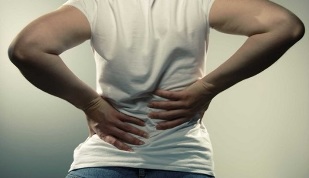
Let us list the main symptoms of lumbar osteochondrosis:
- Pain in the lumbar spine, painful in nature, aggravated by sudden movements, change of body position, prolonged stay in one position. Pain reduction occurs when you take a horizontal position;
- Along with low back pain, osteochondrosis can give a feeling of weakness in the lower torso and legs, as well as loss of tendon reflexes of the lower extremities;
- Bending of the lumbar spine is common. Depending on where the curvature is observed, we distinguish between scoliosis (curvature of the spine to the right or left), lordosis (forward curvature) and kyphosis (mitigation of lumbar curvature);
- If osteochondrosis has resulted in spinal cord fixation and dysfunction, the patient may have uncontrolled urination and defecation.
Additional Features:
- coldness of the skin and numbness in the lumbar region, buttocks;
- dryness, skin, blue skin on the lower back and buttocks;
- violation of sweating in the buttocks;
- urinary disorder;
- erectile dysfunction.
These symptoms indicate the onset of the disease and require medical intervention. Treatment of osteochondrosis can be performed in the hospital and at home.
Diagnosis
Diagnosing osteochondrosis involves the use of various methods, mainly palpation of the lumbar spine.
To confirm the diagnosis, the patient is sent for examination using diagnostic equipment:
- Radiography helps to assess the condition of the spine and each vertebra separately. The integrity of the intervertebral discs and spinal canal is also judged indirectly.
- The degree of nerve ending damage and spinal cord lining is determined by tomography. And also assess the condition of the intervertebral discs.
- MRI - used to make a definitive diagnosis.
Accurate diagnosis will help to understand how to treat lumbar osteochondrosis, and what medications and procedures will be required for this.
Complications
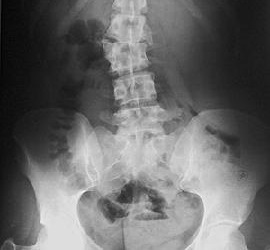
Osteochondrosis of the lumbar spine can cause extensions and hernias due to significant loads on this spine. It is these complications that develop very quickly, so it is very important to treat them in a timely manner.
Furthermore, osteochondrosis can be complicated:
- inflammation of the sciatic nerve;
- spondyloarthritis;
- Hernia and Schmorl;
- osteophytosis, spondylosis;
- spinal canal stenosis with spinal cord compression and dysfunction;
- compression of the cauda equina with dysfunction of the pelvic organs;
- lame;
- paresis of the lower extremities.
it is possible to prevent the progression of complications with timely diagnosis and complex treatment.
Treatment of osteochondrosis of the lumbar spine
When lumbar osteochondrosis is diagnosed, treatment requires extensive complex therapy, which includes:
- moderate physical activity;
- use of medicines;
- spinal traction;
- manual therapy;
- physiotherapy;
- massage.
The treatment scheme for osteochondrosis aims to:
- elimination of the inflammatory process;
- reduction of pain in the lumbosacral region;
- muscle strengthening in the lumbar region, buttocks, legs;
- elimination of pathological muscle tension;
- improving the functioning of the pelvic organs;
- regulation of blood circulation and metabolic processes in the affected area;
- restoring normal range of motion in the lower back and increased sensitivity of the lower extremities.
Surgical intervention is used only in a few cases.
Medications
Such treatment of osteochondrosis of the lumbar spine involves taking pills, injections and external medicines (oils and gels). Medications used to fight this disease relieve pain and stop inflammation.
Depending on the manifestations, your doctor may prescribe different pills for lumbar osteochondrosis:
- pain relievers (analgesics);
- non-steroidal anti-inflammatory drugs;
- muscle relaxants, to relieve muscle spasm caused by pain;
- chondroprotectors that restore cartilage tissue;
- corticosteroids (prescribed if all other treatments have failed);
- vitamin preparations.
Very often in the treatment of osteochondrosis, pills that calm the nervous system are prescribed, as well as antidepressants that fight stressful situations and depression.
Physiotherapy for lumbar osteochondrosis
As a rule, medicines alone are not enough to treat osteochondrosis. Physiotherapeutic procedures are used to eliminate pain, relieve muscle spasm and stimulate metabolic and recovery processes:
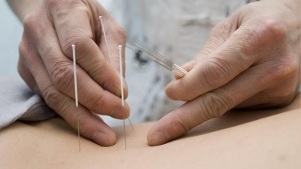
- amplipuls; phonophoresis
- ;
- diadynamic currents;
- darsonvalization;
- magnetic resonance therapy;
- laser therapy.
Massage is prescribed when the main symptoms of pain are removed or during remission in chronic pathology. Serves to relax tense muscles. Often combined with heating procedures or a visit to the sauna. This will help increase the relaxing effect on muscle tissue and stimulate blood circulation.
Manual therapy, which is performed only by a specialist in this field of treatment, increases blood circulation to the spinal cord, replaces the displaced discs of the spine.
Healing gymnastics
The whole complex of exercises used in the diagnosis of lumbar osteochondrosis should help increase the mobility of the lumbar spine.
Healing gymnastics will not be effective if the exercises are performed occasionally. The main principle of exercise therapy is regularity. Continuous implementation of a certain set of exercises will help eliminate destructive processes in the intervertebral joints.
Surgery
Usually, a doctor will only order surgery if serious complications develop. For example, an intervertebral hernia. The most common type of surgery is removal of the damaged disc (discectomy).
This operation is considered to be the most productive method in this case, but at the same time, it is prescribed only if other treatment methods do not bring results within six months. In addition, the method of microsurgical and endoscopic treatment of the spine is widespread.

























